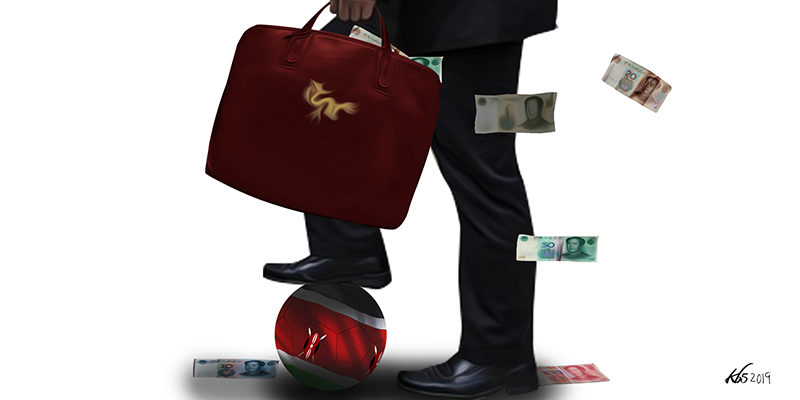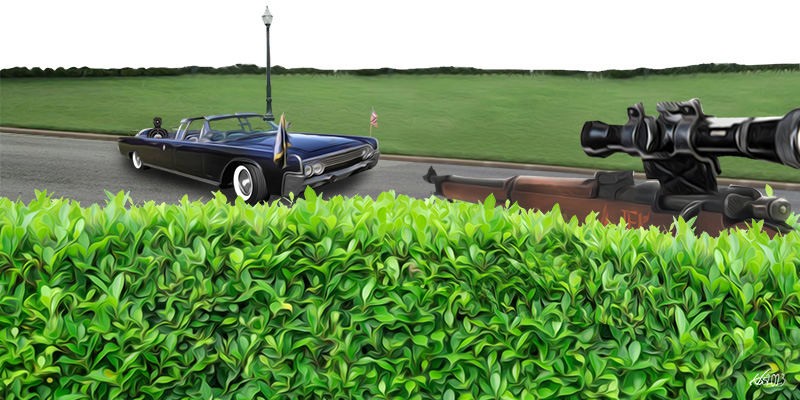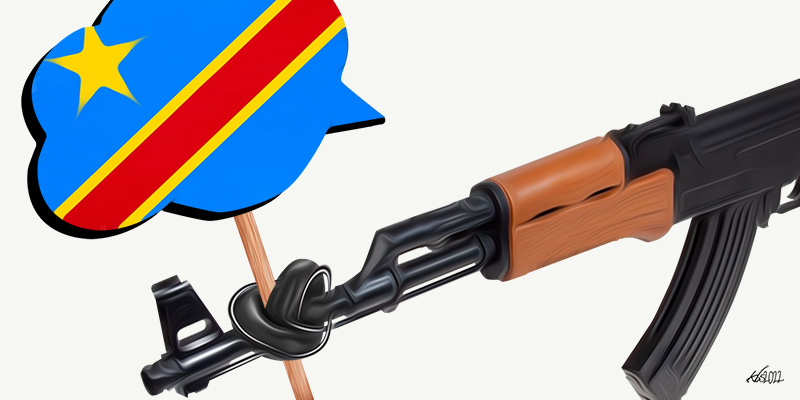In the sprawling congested tenements of Kiamaiko, just behind Jonsaga area in Huruma, Nyawira (not her real name) used to be the gossip of her flatmates for the longest time. She was married to a Chinese man who had come to the country as a road construction worker in the mid-2000.
“I used to sell edibles to the Chinese workers, who had begun constructing Thika Road and that’s how we met,” said Nyawira somewhat nostalgically, remembering those days that she daily interacted with the Chinese. “It was my first time to meet with the Chinese people – they spoke neither English nor Kiswahili and I didn’t speak their language Mandarin. But they needed to eat and I needed to sell food. It is the story of how human beings can overcome imagined obstacles in order to relate.”
By the time the Thika superhighway was nearing completion, Nyawira and her Chinese friend were an item. They had even moved together in Kiamaiko and today their 12-year-old son is a testament to that liaison.
But the romance did not last long. “A couple of years back, he told me he had to head back home for some urgent matter I have not seen him since,” explained Nyawira.
In Nyawira’s neighbourhood, there are two Chinese men who share a one-bedroomed house. “The two men are my water clients,” said Zangi, one of the water vendors that supply water in 20-litre jerricans to Kiamaiko’s residents. “These Chinese have adapted to the local situation, they are just like our people.”
At Eastlands Hotel on Ring Road Kilimani, a wholly Chinese-owned deluxe hotel for Chinese tourists who cannot afford to stay at the city’s high-end hotels, I met Wamaitha (not her real name), an ordinarily very talkative and outgoing person, but only when her Chinese husband is not around. A consummate businesswoman, she met her Chinese mate at a business convention. She is in her early 30s, and her tummy is already showing a noticeable bump – a telltale sign that soon she will be expecting a baby. “My husband is also a businessman, dealing in precious stones,” said Wamaitha, who is from Kerugoya in Kirinyaga County.
To date, the most famous of these Chinese marriages has been that of Liang Yongyu and his 29-year-old wife, Karen Ngunjiri, who married recently. It became a public matter when an unknown fellow who must have attended the wedding uploaded their exclusive marriage ceremony video (the couple says they don’t know who did it) that went viral. Ngunjiri said her wedding to a Chinese man really excited Kenyans for reasons she cannot quite fathom.
Nyawira’s and Wamaitha’s inter-racial relationship stories with the Chinese is the story of diversity of the Chinese people who come to Kenya: from the construction worker to the polished entrepreneur, the Chinese migrants in the country have been causing socio-cultural ripples with their unparalleled quick adaptability to the local environment. “In the next 50 years in Kenya, the Chinese people are going to integrate into the Kenyan society in ways that can only be unimaginable today,” said Christom Karimi, a Kenya-Chinese cultural expert, who speaks perfect Mandarin.
To date, the most famous of these Chinese marriages has been that of Liang Yongyu and his 29-year-old wife, Karen Ngunjiri, who married recently. It became a public matter when an unknown fellow who must have attended the wedding uploaded their exclusive marriage ceremony video that went viral.
Inter-racial families in Kenya have never been a big deal; they are prevalent, especially among white men and indigenous Kenyan women. The white folk in Kenya has been around for long, and their liberal Western culture, English language, Christian religion and general demeanour have made it easier for Kenyan girls to easily gel with them. Not so with the Chinese, whose Oriental culture, language and even religion and their “peculiar” culinary habits have been alien to Kenyans. Chinese people eat dogs, cats and even frogs. These cuisine recipes would test the taste buds of even the strongest Kenyans, who are otherwise known to enjoy international menus.
Early this year, at Diamond estate in South B, Nairobi, a German shepherd went missing. A notice was plastered on the main gate to the estate. After a couple of days, when the garbage collectors came to pick the trash, they found the dog’s head in one of the dustbins. A security meeting was called and the people confronted one of the Chinese estate residents. He owned up to rounding up the canine and agreed to pay a fine of Sh35,000.
Usually, when a local girl gets married to a white man in Kenya, she is whisked off to a posh suburban area: these girls believe they have crossed the Rubicon; it is a mark of upward mobility and privileged social status. Not so with the inter-racial Chinese marriages between Chinese men and Kenyan women; like Nyawira, many end up living in shanty towns.
Where it all began
In 2009, three Chinese companies were contracted by the Kenyan government to build the Nairobi-Thika superhighway. These companies imported Chinese migrant labour who did the actual road construction. The Chinese workers lived in makeshift tin shacks with makeshift mobile toilets in a compound that was sealed from the rest of the Kenyans. The biggest construction site was at the huge Globe Cinema roundabout, where the construction of the 50 km superhighway began. The roundabout is just 500 metres from Nairobi’s central business district (CBD).
The Chinese workers were under strict instructions from the companies’ general managers not to meander into the CBD. So the only meaningful interactions the Chinese workers had with Kenyans was during tea and lunch breaks. At tea break, they would be served African tea and mandazi (a doughnut-like delicacy). For lunch, they were served local cuisine. The food usually included, ugali, githeri, chapati and broth made of turtle beans and green grams. Many of the girls and women who sold food at the site were from Mathare Valley, a large informal settlement that borders the Thika superhighway – the language barrier notwithstanding.
Five years later, in 2012, when the $360-million road was opened by President Mwai Kibaki, the Chinese migrant labour had not only completed the road and overpass bridges, they had also invested in creating inroads and building bridges among the local female populace. Referred to as chinku – the ghetto slang name for the Chinese, the Chinese quickly learned the local lingua franca Sheng, the colloquial language spoken in shanty towns across Nairobi.
Today, the Chinese have not only married local girls and become assimilated into Kenyan life, they have also ventured into informal businesses, a preserve of Nairobi’s rank and file that lives in Eastlands, the poorer part of the city. The resilience of the Chinese came to light when they started trading at Gikomba Market, the largest second-hand clothes market in East and Central Africa. Gikomba Market, a stone’s throw away from Mathare Valley, is a bedlam of activities: you would have to be made of tough metal to conduct business there.
Not all the local women were as lucky as Nyawira and Wamaitha to be in steady relationships, Nyawira’s hubby later disappearance notwithstanding. There are many the tale of Chinese men who have sowed seeds wherever they worked and moved on, either back to China, or relocated to other working sites.
In Mathare 4B, Njeri was not as lucky: she was abandoned by her Chinese mate even after having two children with him. She was also serving food to the Chinese on Thika superhighway. Her two boys are now big – one is about 8 years old, while the other is 10.
Mathare Valley is a hellish place. Reminiscent of the favelas of Port Alegre and Rio de Janeiro, in Brazil, life in the slum is short, nasty and brutish. Among the children hopping over the open flowing sewers and mounds of garbage strewn all over are Njeri’s children, who have continually drawn attention from fellow children, not so much because of their fairer skin complexion, but more fundamentally, because of the shape of their eyes.
Such mixed-race children – often referred to as “Chikuyus” – can also be seen in other parts of the country. Last month, in Gitaru, Muthure village, a married woman gave birth to a baby that created a buzz among the villagers: the baby looked Chinese. When she was asked to explain the anomaly, she owned up to having an affair with a Chinese construction worker. The Gitaru–Wangige Road is currently under construction by the Chinese. Local folklore has it that when she was asked to identify the man, even after they were paraded for identification, she could not pick him. The joke going around is that all Chinese men look alike.
Such mixed-race children – often referred to as “Chikuyus” – can also be seen in other parts of the country. Last month, in Gitaru, Muthure village, a married woman gave birth to a baby that created a buzz among the villagers: the baby looked Chinese.
This is the same joke-story that Purity told me in Mwihoko, Githurai. Purity was a food seller at the Githurai roundabout during the road construction. Over time she befriended a Chinese man. When he impregnated her, he disappeared. “Ï went looking for him, among his colleagues, I couldn’t find him. That was 10 years ago, because that is how old her daughter is,” she said.
The Chinese invasion
The Chinese have not only been marrying local girls, impregnating the ones they could, and engaging in retail business, they have also, surprisingly, been attending church – mostly evangelical churches – and have even started local branches of international churches. To most Kenyans, the Chinese people are not known to worship the Christian God, much less worship God at all. This view traces its origin to the Chinese history as a majority of Kenyans understand it: that China has always been a communist country that has no place for God or religious activities.
Emboldened by the warm reception of a Christianised population, where 80 per cent of the country, nominally or otherwise, belongs to the various Christian denominations, the Chinese migrants are starting evangelical type churches even in rural Kenya. At Gambogi, a trading centre on the Kakamega-Kisumu Road, the Chinese construction workers who are building the 60km road between the two towns have colonised the Gambogi PAG (Pentecostal Assemblies of God) Church, situated just beside the road. Gambogi PAG Church, which has meetings in rented premises, has now added the name China to its church label to read China Gambogi PAG Church.
Today, there are three main Chinese churches in Nairobi, all run by pastors from abroad. The pastors, mainly from Hong Kong, Taiwan and Malaysia, are plying their trade in posh suburban areas in Nairobi. The Bread of Life Church, which is the better known of the Chinese churches, meets in a tall office block and caters mostly to employees of the Standard Gauge Railway (SGR), CGTN, the Chinese government broadcasting media house, and the business community.
Even though many of the migrant Chinese in Kenya are of evangelical persuasion, not all of them attend such churches. It is 4.00 pm at the Jehova Witness Kingdom Hall on Elgeyo Marakwet Road where the faithful meet every Sunday. A special service is going in Mandarin. Here, a group of Chinese Jehova Witness followers meet to fulfil their religious obligations. The meeting, incidentally, is not exclusively for the Chinese; there are Kenyans there, who by the virtue of attending these meetings, have learnt Mandarin.
The majority of these Chinese people live and operate around the radius between Ngong Road, Argwing Kodhek Road and Ring Road, Kilimani. Many of their social-economic activities are centred around this area. At the Chinese Centre on Ngong Road, for example, they can shop at their supermarkets, which cater solely to their needs. At Park 53 building on Ring Road, 90 per cent of the businesses, mostly restaurants, are owned by the Chinese. Because many of them do not speak the local lingua franca, English and Kiswahili, they tend to huddle together, hence live communally in the same area.
Amid all these Chinese activities in the country, their seemingly unchecked influx has apparently been causing disquiet among Kenyans, especially among small traders and the business community, who engage in the importation of merchandise. Kenyans tend not to be xenophobic, but the Chinese community is quietly and slowly eliciting xenophobic rhetoric among Kenyans.
The majority of these Chinese people live and operate around the radius between Ngong Road, Argwing Kodhek Road and Ring Road, Kilimani…At the Chinese Centre on Ngong Road, for example, they can shop at their supermarkets, which cater solely to their needs.
Several weeks ago, the MP for Starehe constituency, Charles Njagua, stoked xenophobic fears when he accused foreigners, who obviously included the Chinese, of monopolising all the businesses that “belong” to Kenyans. In his inciteful remarks, the MP said if the government did not take any “stern measures” against the foreigners, he would lead the people in ferreting out the foreigners out of the country. The MP has since recanted his statement, arguing that he was quoted out of context. But the point had already been made.
Traders on Gaberone Lane, the 100m backstreet alleyway behind Gaberone Road in downtown Nairobi supported and loudly voiced the xenophobic rhetoric against the Chinese. It is not difficult to see why. They all deal mainly in fabric and textiles materials, all imported from China. “Since the Chinese entered into this business, our businesses have gone down, they have been doing everything to undercut us by their price differentiation” said Ken Mutahi, who has been importing fabrics from China for the last 15 years.
“The Chinese have the unparalleled advantage of buying the materials directly from the factories, in their own country, while we buy from retailers. It has become increasingly impossible to compete with them, because all they need to do is lower their prices a little bit and they will still be within their profit margin,” complained Mutahi. He said that the traders were furious with the government for allowing the Chinese to “invade” their businesses. “Which government allows foreigners to overrun businesses meant for the locals?”
At Gikomba Market, anger has been building up against the Chinese traders, who have taken the second-hand clothes business by storm. “Chinese are now some of the biggest middle men, involved in selling thousands of bales of clothes,” said Elvis Kariuki, himself a trader at the market since the early 1990s. “We have been asking ourselves what kind of work permit these Chinese are on that allows them to engage in such businesses,” said Kariuki. Seemingly better organised and with a lot more capital than the local traders, the Chinese have been buying huge stocks of second-hand clothes mainly imported from the United Kingdom and filling all the warehouses in Gikomba.
“Expatriates who come to the country should be bringing in [new] knowledge and skills that maybe scarce or non-existent – why does the government allow the Chinese to come and take our jobs?” posed Kariuki. The trader said many of the Gikomba Market traders who have never known or done any other work, other than selling second-hand clothes, are very bitter with both the government and the Chinese traders.
The Chinese have not only infiltrated the second-hand clothes market, they are also involved in importing – from their own country – merchandise that was the sole preserve of the small traders. In downtown Nairobi, Chinese traders are running shops and renting stores which they stock with stuff imported from China. These items include cheap feature mobile phone handsets, their spare parts and hi-fi equipment such as hoofers.
“Some of the Chinese traders doing business in Kenya have been contracted by local companies back at home,” said a Kenyan trader who has been in the business of importing the same stuff. “The Chinese traders then become the conduits for creating new markets for the products manufactured back in China.”
The Chinese traders, on the other hand, have a different view of themselves. Some of the Chinese traders I spoke to said that they were not taking away anybody’s job or business – all they were doing was engaging in market competition. “We just happen to be aggressive and versatile,” some of one Chinese trader.
Forty-year-old Alex Cao (pronounced Chao), originally from Tianjin, came to Kenya seven years ago. He said he found his niche in real estate development. “It is never a smooth sail,” said Cao. “Dexterity is the name of the game if you have to survive the market onslaught.”
Richard Ling, 30, hails from Guangzhou and has been in Kenya for only three years. A trader, he hawks merchandise, including mobile phone gadgets, chargers, power banks, and torches, from his small rented stall at Kamukunji market building in downtown Nairobi.
Sixty-year-old Ling Fang came to Kenya 20 years ago. His wife joined him 10 year later. They found success in selling and stocking drapery and other upholstery materials, which they import in bulk from their country. From their shop on Biashara Street, they have engaged in both retail and wholesale business.
The dexterity of the Chinese in Kenya has seen them diversify in all manner of businesses. At the Eastmart supermarket on Tom Mboya Street, one of the upcoming suppliers of confectioneries is a Chinese man who makes doughnuts, shortcakes and cupcakes. “Every morning by 8.00 am, the Chinese man will deliver his goods without fail,” said the supermarket attendant who is in charge of the bread and cakes section. “His prices are between Sh10 and Sh20 cheaper and his cakes are slightly bigger, so they move faster.”
At their peak in 2015, there were about 40,000 Chinese in Kenya, but Karimi told me that over the couple of past years, the number could have gone down to between 30,000 and 35,000. According to Howard French, a journalist who has written the book, China’s Second Continent, there are upward of one million Chinese people in Africa.
“The Chinese who are always looking for favourable places to do business have recently been migrating to Ethiopia. The Ethiopian economy is growing at a steady pace, the government has reduced much of the red tape associated with starting businesses for foreigners and their tax regime is not as punishing,” Karimi said.
At their peak in 2015, there were about 40,000 Chinese in Kenya, but Karimi told me that over the couple of past years, the number could have gone down to between 30,000 and 35,000. According to Howard French, a journalist who has written the book, China’s Second Continent, there are upward of one million Chinese people in Africa.
By 2017, China had become Kenya largest trading partner. In 2017, it built a new railway line, at the cost of $3.18 billion, the most expensive infrastructure expenditure in Kenya since independence.
Two years ago, perhaps in an effort to endear themselves to Kenyans, a Chinese philanthropic group started a feeding programme in eight informal primary schools in Mathare 4A. The biggest of these schools, Chang Rong – which translates as Mathare Light Centre – is the biggest, with 400 pupils. Collins Abongo, a teacher at the school, told me the Chinese also sponsor a football tournament among the eight schools.








